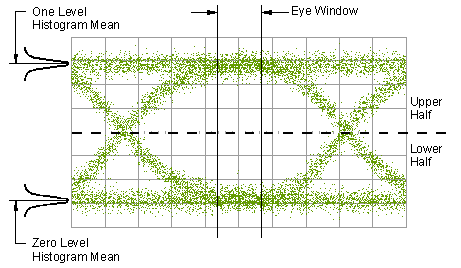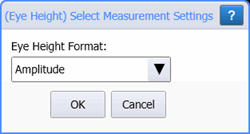Eye Height

 The Eye mode Eye Height is a measure of the vertical opening of an eye diagram. An ideal eye opening would be measured from the one level to the zero level. However, noise on the eye will cause the eye to close. The eye height measurement determines eye closure due to noise. Four annotation labels are placed at the eye opening. Two labels are placed at the mean value of the one level and two at the mean value of the zero level. Each set of labels resides on the eye boundaries. In order to make an accurate eye height measurement, histograms are constructed to characterize both the one and zero levels and their noise levels within the eye window boundaries. The one and zero level measurements are made in a section of the eye referred to as the eye window boundaries. The default value for NRZ eye window boundaries is the central 20% of the symbol period.
The Eye mode Eye Height is a measure of the vertical opening of an eye diagram. An ideal eye opening would be measured from the one level to the zero level. However, noise on the eye will cause the eye to close. The eye height measurement determines eye closure due to noise. Four annotation labels are placed at the eye opening. Two labels are placed at the mean value of the one level and two at the mean value of the zero level. Each set of labels resides on the eye boundaries. In order to make an accurate eye height measurement, histograms are constructed to characterize both the one and zero levels and their noise levels within the eye window boundaries. The one and zero level measurements are made in a section of the eye referred to as the eye window boundaries. The default value for NRZ eye window boundaries is the central 20% of the symbol period.

The one and zero levels are the relative means of the histograms. The noise is measured through the histograms as three standard deviations from both the one level and zero level into the eye opening.

The eye height is determined as follows:


You can also choose to view eye height as a ratio of the Eye Height to Eye Amplitude measurements, which indicates how much the eye diagram has closed due to noise. If Amplitude format is selected, the measurement is listed in the table as Eye Height[Ampl]. If ratio format is selected, the measurement is listed in the table as Eye Height[Ratio].
This measurement applies to NRZ waveforms and not to PAM4 waveforms.
Configurable Measurement Parameters
This measurement is affected by the following setting (click Measure > Configure Base Measurements):
- Eye Boundary tab
To measure
- Select Eye/Mask Mode.
- Click the toolbar's Eye Meas tab.
- Click Auto Scale in the menu bar.
- Click the button and select the measurement format: Amplitude or Ratio.

SCPI Command
:MEASure:EYE:EHEight